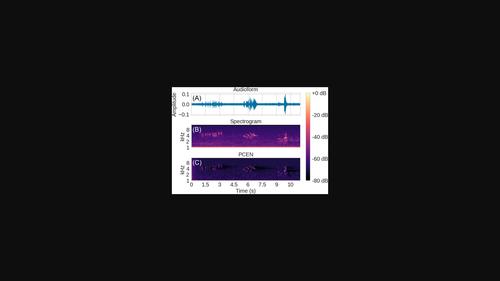当前位置:
X-MOL 学术
›
Wildl. Soc. Bull.
›
论文详情
Our official English website, www.x-mol.net, welcomes your feedback! (Note: you will need to create a separate account there.)
An efficient acoustic classifier for high-priority avian species in the southern Great Plains using convolutional neural networks
Wildlife Society Bulletin ( IF 1.5 ) Pub Date : 2023-10-04 , DOI: 10.1002/wsb.1492 Brandon Wolfe 1 , Mike D. Proctor 2 , Victoria Nolan 3 , Stephen L. Webb 4
Wildlife Society Bulletin ( IF 1.5 ) Pub Date : 2023-10-04 , DOI: 10.1002/wsb.1492 Brandon Wolfe 1 , Mike D. Proctor 2 , Victoria Nolan 3 , Stephen L. Webb 4
Affiliation

|
Passive acoustic monitoring is a valuable ecological and conservation tool that allows researchers to collect data from vocal species across large geographic areas and temporal spans. Grassland bird populations, many of which are indicators of ecosystem health, have experienced precipitous declines over the past several decades. Acoustic monitoring of grassland bird populations provides opportunities to monitor declines and focus conservation practices, yet the ability to identify species efficiently and accurately from acoustic data is challenging. Therefore, development of automated classifiers such as convolutional neural networks (CNNs) are at the forefront of streamlining detection and identification of individual species. Here, we present a CNN classifier for 5 key grassland bird species across southcentral Oklahoma, a part of the southern Great Plains: northern bobwhite (Colinus virginianus), painted bunting (Passerina ciris), dickcissel (Spiza americana), eastern meadowlark (Sturnella magna), and Bell's vireo (Vireo bellii). We compiled a high-quality training dataset consisting of 6,933 calls, built semiautonomously using template matching that can be expanded easily to any bird species of interest. Our trained multilabel CNN achieved a high level of classification accuracy (≥98%) for the 5 species using the library of test calls and field recordings played using a programmable game caller. The ability to conduct acoustic wildlife surveys across large spatial extents will allow for more efficient monitoring of wildlife to determine key population parameters and trends and effects of biotic and abiotic factors (e.g., vegetation, disturbance, weather) on these key species.
中文翻译:

使用卷积神经网络对大平原南部高优先级鸟类物种进行有效的声学分类器
被动声学监测是一种有价值的生态和保护工具,使研究人员能够从大地理区域和时间跨度的发声物种中收集数据。草原鸟类数量(其中许多是生态系统健康的指标)在过去几十年中经历了急剧下降。对草原鸟类种群的声学监测为监测鸟类数量下降和重点保护实践提供了机会,但从声学数据中有效、准确地识别物种的能力具有挑战性。因此,卷积神经网络 (CNN) 等自动分类器的开发处于简化单个物种检测和识别的最前沿。在这里,我们为俄克拉荷马州中南部(大平原南部的一部分)的 5 种主要草原鸟类提供了 CNN 分类器:北短白鹀 ( Colinus virginianus )、彩鹀 ( Passerina ciris )、迪克西塞尔 ( Spiza americana )、东部草地鹨 ( Sturnella magna ))和贝尔绿鹃(Vireo bellii)。我们编译了一个由 6,933 个呼叫组成的高质量训练数据集,使用模板匹配半自主构建,可以轻松扩展到任何感兴趣的鸟类物种。我们训练有素的多标签 CNN 使用测试呼叫库和使用可编程游戏呼叫器播放的现场录音,对 5 个物种实现了高水平的分类准确率 (≥98%)。在大空间范围内进行野生动物声学调查的能力将有助于更有效地监测野生动物,以确定关键种群参数和趋势以及生物和非生物因素(例如植被、干扰、天气)对这些关键物种的影响。
更新日期:2023-10-04
中文翻译:

使用卷积神经网络对大平原南部高优先级鸟类物种进行有效的声学分类器
被动声学监测是一种有价值的生态和保护工具,使研究人员能够从大地理区域和时间跨度的发声物种中收集数据。草原鸟类数量(其中许多是生态系统健康的指标)在过去几十年中经历了急剧下降。对草原鸟类种群的声学监测为监测鸟类数量下降和重点保护实践提供了机会,但从声学数据中有效、准确地识别物种的能力具有挑战性。因此,卷积神经网络 (CNN) 等自动分类器的开发处于简化单个物种检测和识别的最前沿。在这里,我们为俄克拉荷马州中南部(大平原南部的一部分)的 5 种主要草原鸟类提供了 CNN 分类器:北短白鹀 ( Colinus virginianus )、彩鹀 ( Passerina ciris )、迪克西塞尔 ( Spiza americana )、东部草地鹨 ( Sturnella magna ))和贝尔绿鹃(Vireo bellii)。我们编译了一个由 6,933 个呼叫组成的高质量训练数据集,使用模板匹配半自主构建,可以轻松扩展到任何感兴趣的鸟类物种。我们训练有素的多标签 CNN 使用测试呼叫库和使用可编程游戏呼叫器播放的现场录音,对 5 个物种实现了高水平的分类准确率 (≥98%)。在大空间范围内进行野生动物声学调查的能力将有助于更有效地监测野生动物,以确定关键种群参数和趋势以及生物和非生物因素(例如植被、干扰、天气)对这些关键物种的影响。



























 京公网安备 11010802027423号
京公网安备 11010802027423号